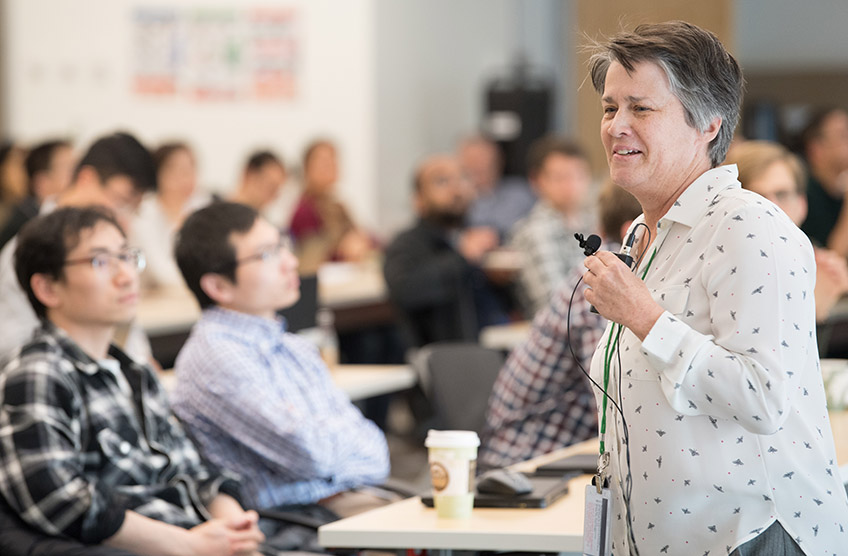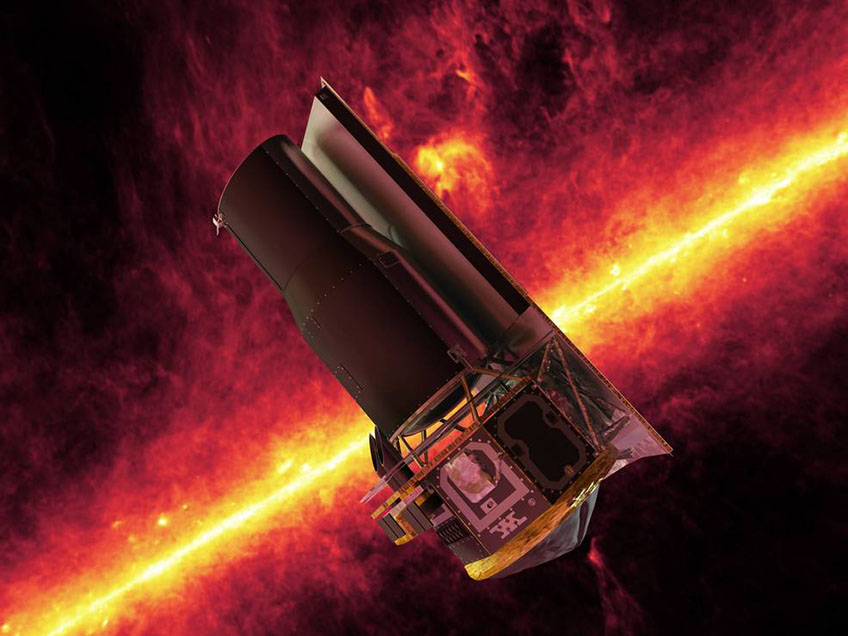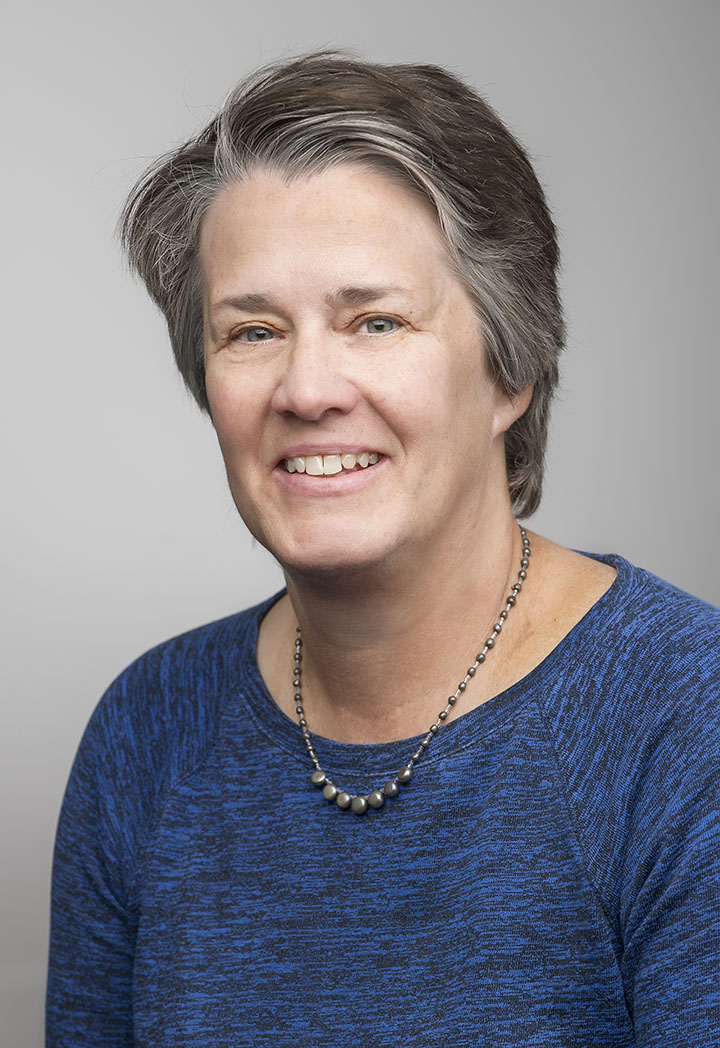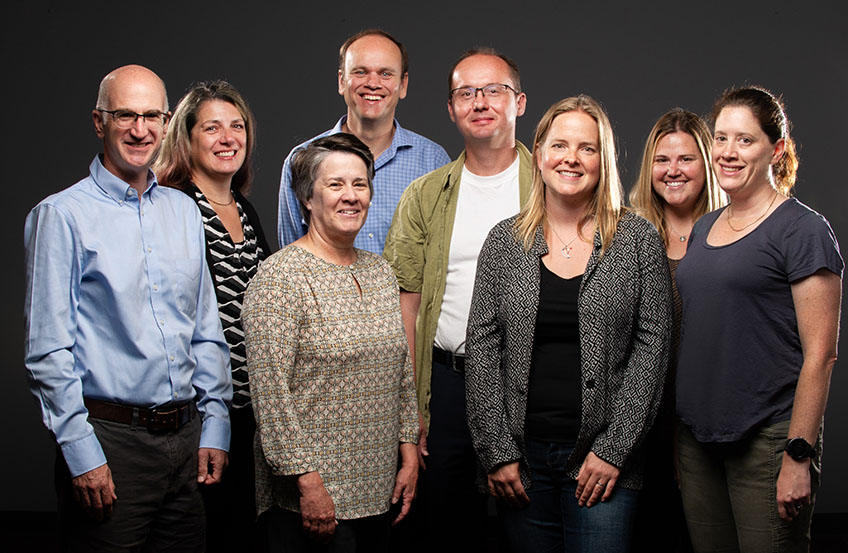Scientist Nancy Haegel Uses the Elegance of Physics To Guide Materials Research

National Renewable Energy Laboratory (NREL) Materials Science Center Director Nancy Haegel was not asleep during the wee hours of August 25, 2003.
Instead, Haegel—then a physics professor at the Naval Postgraduate School in Monterey, California—was monitoring NASA’s dawn launch of the Space Infrared Telescope Facility, taking place nearly 2,900 miles away at Cape Canaveral Air Force Base in Florida. The $750 million satellite was designed to see the optically invisible universe, piercing through dust and clouds.
Her fingerprints were on some semiconductor light detectors aboard the craft (later renamed the Spitzer Space Telescope). During that time, Haegel also worked on semiconductor materials for solar cells, radiation detectors, and light emitters—all areas that have helped inform her activities at NREL.
“Semiconductors are wonderful things, right?” Haegel said. “They absorb and emit light, can be used in integrated circuits, as well as in space astronomy to detect light of all wavelengths.”
Haegel had begun researching semiconductors during graduate school at the University of California, Berkeley years before. She explored ways to use them to detect far-infrared light. The study was fruitful because semiconductor materials absorb far-infrared wavelengths, a region in the infrared spectrum of light, and can create electrical signals.
“We worked on the materials and the physics for the detectors,” she said. “These detectors have to operate in extreme cold, a few degrees above absolute zero. You have to understand exactly how the detector is going to behave at those temperatures.” Haegel and her team were “identifying the best materials and then understanding how they would respond to changing light levels in space.”
For five years after the blast off, the satellite sent back vital data while drifting in an Earth-trailing orbit around the sun. Gradually, its power waned, the detector and other instruments stopped communicating, and on January 30 this year, NASA retired Spitzer.
While the Spitzer chapter has ended, Haegel’s quest that started with grade-school science projects in Ohio is still going strong.

Born in New Haven, Connecticut, Haegel moved with her family to Ohio as a girl when her accountant father was transferred there. Her mother, a former Latin teacher, looked after their three children.
Although not determined to be a scientist, “I did enjoy the science fair part of school,” Haegel said. Every year, from fourth through eighth grades, she eagerly participated. “I didn’t build a cyclotron,” she laughed. “I did build a studio for testing visual perception. I remember having dark rooms, and flashing things on the wall.” In high school, she formally encountered physics, aided by an excellent teacher. “I liked the elegance of it. Physics is a discipline where you try to simplify things to their most fundamental.”
The concept resonated with her personality. When she chose to attend Notre Dame University as an undergraduate, she weighed the idea of majoring in engineering or physics although she also liked history. “It occurred to me that I could read history and enjoy it on the side. It was going to be a little harder to do some of the experimental science as an avocation.”
Instead, she chose to major in material science. “It struck me as a field—an engineering discipline—that was close to physics, but word on the street was that you didn’t have to go to grad school.” That was key because she had not gone to college thinking about graduate school. Her parents were the first in their families to attend college. “I grew up with the idea that a college education was a wonderful gift” but not a gateway to grad school.
Yet her mentors saw her great potential and urged her on. Haegel applied for and won a National Science Foundation (NSF) graduate fellowship. Berkeley became a natural next step as an institution that collaborated closely with Lawrence Berkeley National Laboratory (LBNL). “I did most of my research up on The Hill,” as LBNL was called due to its location. And it was then that she learned about NREL. “LBNL was also strong in the semiconductor field, and my thesis advisor had ties to NREL’s Alex Zunger and the early III-V solar work done here.” At the time, she did not envision coming to Colorado. By 1985, she had finished her Ph.D. in material sciences and she was ready for an adventure.
“I had missed any chance for foreign study as an undergrad,” she said. And when an official of the Siemens Research Laboratory in Erlangen, Germany, offered a postdoctoral position, Haegel accepted. Although her family heritage was German, she did not speak the language. To prepare, she started taking classes prior to heading to Germany. “It was a crash course,” she said, one that continued in Germany after hours. She spent 18 months in semiconductor research at the firm she described as “Germany’s General Electric.” Still, others had warned her that taking such an unusual postdoc would hurt her chances for finding a teaching position back in the U.S.

Haegel proved them wrong.
She landed a position at the University of California, Los Angeles (UCLA) as an assistant professor of materials science. It began a pattern of teaching—and changing jobs every eight to 10 years. Although she enjoyed the diverse student body, she was drawn back to her home state to help care for her elderly mother. She found a job at Fairfield University, a largely undergraduate institution in Fairfield, Connecticut. “When I went there, they didn’t have an engineering school, so I was in the physics department.” She was able to keep her NSF and NASA funding for research and continued her program, working in the lab herself with her students. “I believe in doing my own work. It keeps you honest and grounded.”
However, she had promised her engineer husband, Bill, that they would return to California someday. After she was no longer needed for her mother’s care a decade later, she began searching for a job. “I found mine by looking in Physics Today. Nobody does that today. I sent my resume to the Naval Postgraduate School on a whim,” she said. Haegel was hired in 2003 to teach physics.
“It’s a wonderful place,” she said, noting it was not a military academy but a mixture of students. “There are civilians there as well as military officers from 30 to 40 countries,” she said.
She enjoyed the challenge, adding that from teaching undergraduates to graduates and then postdocs, she has experienced teaching all levels. “Every group brings something different, which helps you to grow as a teacher.”
Content, she expected to finish her career in scenic Monterey. Then she heard from NREL Associate Laboratory Director for Materials and Chemical Science and Technology Bill Tumas. His message: NREL wanted her.
Becoming the “Grease” at NREL
Haegel arrived at NREL in 2014—a decision made easier, she admits, because her son and his wife had just moved to Colorado. (Her daughter lives in New Jersey). Her impact as leader of the Materials Science Center has been profound.
Said Tumas, “Nancy is an awesome mentor and colleague to many and inspires others to seek excellence, innovation, and teamwork.” He added, “At the same time, she continues to be an excellent resource to me, providing sound advice and action on scientific directions, inclusion, personnel issues, collaborations, planning, and execution.”
Others echo the praise, often citing mentorship. “My group is calm, confident, focused, and efficient right now. Much of that is due to her leadership,” said NREL Group Manager Teresa Barnes. “Nancy supports our principal investigators regularly, understands our challenges, knows our early career scientists, and is genuinely interested in our work,” Barnes said. “We know she has our backs, always wants to help us get better, and appreciates our work.”
For her part, Haegel is a bit more reserved, especially when referring to mentorship. “I’ve always seen it as a key part of my vocation and whatever I’m doing, as a faculty member or in management. I don’t use the term ‘mentor’ a lot myself,” she explained, because she came of age before talking in those terms was common. “I see it more as being part of the team. If you have a little more experience, or are a little older, then maybe that’s the role you take on as a member of the team. Everybody on the team should be trying to help everyone else in whatever way they can.”
In recognition of her ability to inspire, NREL presented her in March with the Van Morriss award, given annually for a technical or administrative staff member who is a leader in the growth and development of MRIGlobal, Battelle, and NREL.
Thanking her colleagues at the awards assembly, Haegel quipped, “As a professor, I could always tell people what I did. When people ask what I do here, I’m never quite sure what to tell them. And so, in our center, I think the joke is that I am expensive grease”—pushing to help projects go forward with less friction. She added that Laboratory Director Martin Keller’s list of her accomplishments when introducing her “makes me feel a little better.” After the crowd finished laughing, she concluded, “I enjoy every day being expensive grease for such bright, committed people who are doing such great work.” Her role, overall, is to “make sure people don’t get stuck.”

Building for the Future
The initiatives Haegel has accomplished so far at NREL are impressive, including:
- She continues to build on collaborative initiatives with universities, especially the Colorado School of Mines (CSM), including jointly establishing the International Center for Multiscale Characterization (ICMC) with CSM and the emerging CSM/NREL Nexus center.
- She has launched the materials science seminar series, the energy fellowship program, and other activities keeping NREL materials science and related areas at the forefront with CSM colleagues.
- She has spearheaded two Terawatt Workshops. She led the preparation of two manuscripts that were published in Science summarizing the results of each of the first two workshops.
- She has worked to expand partnerships and research, particularly with the U.S. Department of Defense.
Her reach is not limited to NREL, either.
A number of her center’s activities were called out by the U.S. Department of Energy in its fiscal year 2019 assessment, including the Nature cadmium telluride (CdTe) paper with collaborators First Solar and DuraMAT, though Haegel credits that work entirely to the teams involved. Additionally, Haegel was named an American Physical Society (APS) Fellow. A University of Iowa professor wrote that “Nancy’s service to society and profession through the APS Committee on the Status of Women in Physics is just a part of her broader service, research and pedagogical contributions.”
For Haegel, this is just how things should be done.
She wants to move ahead, keeping people on track. But things are not finished. “As Bill [Tumas] would say, ‘We’re not done yet.’ We’ll hit the terawatt milestone for solar global installation in a couple of years.” When NREL research evolves, she will be the grease. “I’m willing to get in and push, grease, to make sure it happens. It’s the same with the Science papers. They’re a real group effort; papers can have 20 co-authors but generally someone has to help keep it moving.”
Haegel is not content to rest on a title as mentor. “I look to the younger staff or former students—the exchange goes both ways. They bring an energy, a new look, a future to a relationship.”
Scanning the horizon, Haegel sees that there is plenty of research to go around with global challenges for renewable energy adoption. “It’ll take all hands on deck, to use a naval phrase,” she said. “I think NREL’s impact historically has been quite strong. We want to keep it there and do work that matters for the country and the world.”
Learn more about Materials Science research at NREL.
Last Updated May 28, 2025
